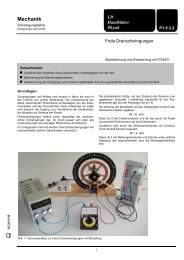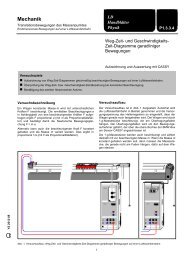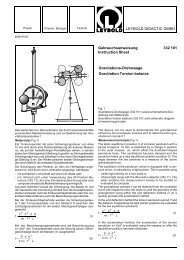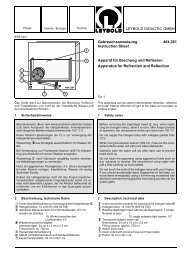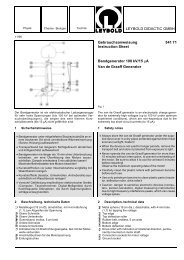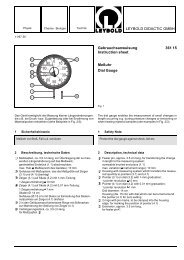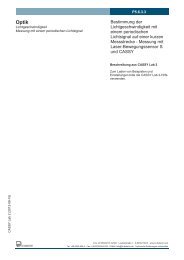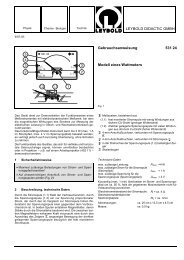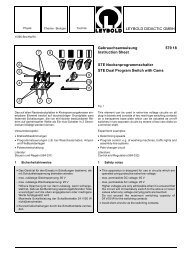LEYBOLD DIDACTIC GMBH Gebrauchsanweisung 389 521 ...
LEYBOLD DIDACTIC GMBH Gebrauchsanweisung 389 521 ...
LEYBOLD DIDACTIC GMBH Gebrauchsanweisung 389 521 ...
You also want an ePaper? Increase the reach of your titles
YUMPU automatically turns print PDFs into web optimized ePapers that Google loves.
Ohne Abbildung:<br />
Kaltwasserbehälter, 5 l, blau markiert<br />
mit zwei Schlaucholiven zum Anschluß eines externen Wasserkreislaufs;<br />
Innenskala mit Literteilung.<br />
Warmwasserbehälter, 5 l, rot markiert<br />
mit zwei Schlaucholiven zum Anschluß eines externen Wasserkreislaufs;<br />
Innenskala mit Literteilung.<br />
2 Schläuche, 1 m lang, Ø 6 mm<br />
Abmessungen:70 cm x 50 cm x 82 cm<br />
Masse: 30 kg<br />
2.2 Funktionsweise<br />
Eine Wärmepumpe entzieht einem Reservoir der Temperatur<br />
T1 Wärme und führt sie einem Reservoir der Temperatur T2 zu.<br />
Dadurch wird der Temperaturunterschied (T1-T2) zwischen beiden<br />
Reservoirs vergrößert. Der Wärmetransport geschieht<br />
über ein Kältemittel R134a , das beim Verdampfen Wärme aufnimmt<br />
und sie beim Kondensieren wieder abgibt.<br />
Die Wärmereservoirs sind gefüllte Wasserbehälter, in die die<br />
beiden "Wärmetauscher" � und � eintauchen.<br />
Das gasförmige Kältemittel wird vom Kompressor � komprimiert<br />
und dabei stark erhitzt. Es kühlt sich in der Kupferrohrschlange<br />
� des Verflüssigers ab und kondensiert, wobei es<br />
seine Kondensationswärme an das Wasser im Warmwasserbehälter<br />
abgibt.<br />
Das verflüssigte, aber noch mit Gasblasen durchsetzte Kältemittel<br />
wird im "Reiniger" � gefiltert. Dieser wirkt gleichzeitig als<br />
"Sammler": In seinem Innern bildet sich ein Flüssigkeitsspiegel,<br />
der eine blasenfreie Flüssigkeitszufuhr für das Expansionsventil<br />
� sicherstellt.<br />
Das Expansionsventil ist das Gegenstück zum Kompressor: Es<br />
dosiert die Kältemittelzufuhr zum Verdampfer �, wo das Kältemittel<br />
sich entspannt, verdampft, sich dabei stark abkühlt und<br />
so dem Kaltwasserreservoir Wärme entzieht. Das nun wieder<br />
gasförmige Kältemittel wird vom Kompressor angesaugt, wo<br />
der Kreislauf von vorne beginnt. Das Expansionsventil �<br />
schützt den Kompressor vor "Flüssigkeitsschlägen", d.h. Ansaugen<br />
flüssigen Kältemittels mit nachfolgender Zerstörung<br />
des Kompressors. Die Kältemittelzufuhr zum Verdampfer wird<br />
nämlich von einem Temperaturfühler � geregelt (daher auch<br />
die genauere Bezeichnung "thermostatisches Expansionsventil").<br />
Als Regelgröße dient die Temperaturdifferenz zwischen Einund<br />
Auslaßrohr des Verdampfers. Fällt diese unter einen bestimmten,<br />
am Expansionsventil fest eingestellten Wert-weil z.B.<br />
die Wärmezufuhr zum Verdampfer zu gering ist-, wird der Kältemittelnachschub<br />
gedrosselt.<br />
Der Druckwächter � schaltet den Kompressor ab, wenn der<br />
Druck auf der Verflüssigerseite 16 bar überschreitet (Einstellung<br />
auf der linken Skala ). Dies kann passieren, wenn der Verflüssiger<br />
� ohne Wasserreservoir betrieben und dadurch zu<br />
warm wird (T2 > 60 °C). Der Kompressor schaltet sich erst dann<br />
wieder ein, wenn der Druck um den auf der rechten Skala eingestellten<br />
Betrag (9 bar) unter den Abschaltdruck gefallen ist.<br />
Durch die Rohrwindungen � am Kompressor-Ein- und Auslaß<br />
wird verhindert, daß sich die Vibrationen des Kompressors auf<br />
das gesamte Gerät übertragen.<br />
3<br />
Not shown:<br />
Cold-water vessel, 5 l, with blue mark<br />
with two hose nipples for connecting an external water circuit;<br />
inner scale with liter divisions.<br />
Warm-water vessel, 5 l, with red mark<br />
with two hose nipples for connecting an external water circuit;<br />
inner scale with liter divisions.<br />
2 tubes, 1 m long, 6 mm dia.<br />
Dimensions: 70 cm x 50 cm x 82 cm<br />
Weight: 30 kg<br />
2.2 Function<br />
A heat pump withdraws heat from a reservoir with the temperature<br />
T1 and transports it to a reservoir with the temperature<br />
T2.<br />
As a result, the temperature difference (T1-T2) between the two<br />
reservoirs increases. The heat is transported by the coolant<br />
R134a, which absorbs heat through evaporation and releases it<br />
when it condenses.<br />
The heat reservoirs are vessels filled with water, in which the<br />
two "heat exchangers" � and � are immersed.<br />
The gaseous coolant is compressed in the compressor �,<br />
which heats it significantly. It is cooled in the spiral of copper<br />
tubing � of the liquefier and condenses, in the process transferring<br />
its heat of condensation to the water in the vessel.<br />
The liquified coolant still contains bubbles of gas, so it is filtered<br />
in the "purifier" �. This simultaneously functions as a<br />
"collector": it accumulates a level of liquid which ensures that<br />
the expansion valve � always receives a bubble-free liquid<br />
supply.<br />
The expansion valve is the counterpart of the compressor: it<br />
regulates the supply of coolant to the vaporizer �, where the<br />
coolant expands and evaporates. In the process it cools down<br />
rapidly, and thus withdraws heat from the cold-water vessel.<br />
The coolant, once more in the gaseous state, is drawn into the<br />
compressor, and the cycle begins anew. The expansion valve<br />
� protects the compressor from "liquid shocks", i.e. suction of<br />
liquid coolant, which would otherwise destroy the compressor.<br />
The supply of coolant to the vaporizer is regulated by a<br />
temperature sensor � (thus the more precise designation<br />
"thermostatic expansion valve").<br />
The temperature difference between the inlet and outlet tubes<br />
of the vaporizer serves as the controlled variable. If this value<br />
drops below a fixed value set at the expansion valve - e.g.<br />
because the supply of heat to the vaporizer is too low - the<br />
supply of coolant is reduced.<br />
The pressure switch � shuts down the compressor when the<br />
pressure on the liquefier side exceeds 16 bar (setting on the<br />
left-hand scale). This can occur when the liquefier � is operated<br />
without a water reservoir and thus becomes too warm<br />
(T2 > 60 °C). The compressor does not switch back on until the<br />
pressure drops below the shutoff pressure by the value set on<br />
the right side of the scale (9 bar).<br />
The spiral tubing sections � at the compressor inlet and outlet<br />
prevent the vibrations of the compressor from being transmitted<br />
to the entire apparatus.



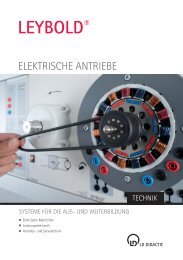
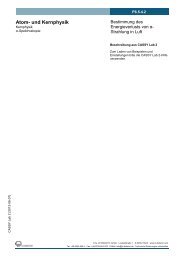
![[667 359] Labor-Refraktometer - LD DIDACTIC](https://img.yumpu.com/24788329/1/184x260/667-359-labor-refraktometer-ld-didactic.jpg?quality=85)
